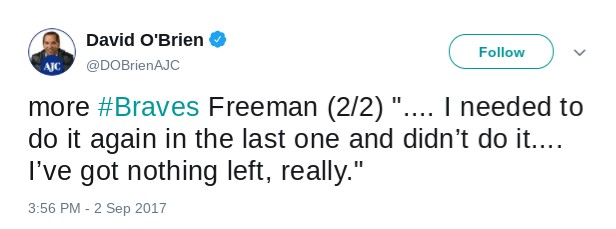| Age: | 28 |
| Bats/Throws: | L/R |
| Height/Weight: | 6'5", 220 lbs |
| Position: | First Base |
After witnessing what Giancarlo Stanton did last year with a full season of health, here’s to wondering what might have been for Freddie Freeman last year. Yes, that Freeman. Some think he broke out in 2016, but prior to incurring a fracture in his wrist last year, a new level seemed to be on the horizon. While this flies below the radar for some, savvy drafters continue to move Freeman up draft boards with a second round ADP this year.
Around this time last year, some mused Freeman’s average draft position of 25 in NFBC drafts seemed too high and it’s true he’s been limited to 118 or fewer games in two of the last three years. At the time of his fracture, Freeman had played in 37 games with 135 at-bats, 14 home runs, 25 RBI and four stolen bases while hitting .341 with a promising 1.082 on-base plus slugging percentage.
His underlying statistics screamed that it was time for the inevitable breakout. Freeman’s first 37 games yielded a .417 isolated power in April and .324 mark in May. He averaged a home run every 9.64 at-bats which fueled a 32-percent HR/FB rate in the first half What if he never suffered the injury?
Upon his return, Freeman did well but not to the level he started the season at. Yes, he did club 14 more home runs over his last 305 at-bats, but he did not record an isolated power in any month following his return higher than .233 and his HR/FB percentage in the second half crumbled to 13.2. What if he never suffered the injury?
Even with the injury issues, during the last three years, Freeman’s accrued 1,445 at-bats with 248 runs, 80 home runs, 228 RBI, 17 stolen bases and a .296/.392/.546 slash line. This provides such a stable baseline to build a fantasy team around. And as hinted at above, there could be another level to Freeman’s game.
He’s in the midst of his power peak in a ballpark built for his swing. This cannot be measured, but Freeman’s hot start to last season featured him hitting better on the road than at home, which may make 2018 the career year fantasy player’s planned on last year. Here’s Freeman’s spray chart from the first 37-game sample of the season:

Freeman hit the ball well to all fields and here’s his plate appearance results to further underscore the chart above:

During a shortened season featuring a wrist injury, Freeman still finished the year by raising his slash lines versus his 2016 results in all three categories, cut his swinging-strike percentage and increased contact without changing his chase rate. In fact, Freeman’s quote from this tweet last year indicates he played through injury at about 80-to-85 percent health after he returned from rehab:

It’s ironic, but Freeman did turn in a statistically strong month in terms of hard-hit percentage (44.8 percent). However, the injury removed the chance Freeman would exceed a home run per fly ball percentage over 20 percent in a season, yet he still recorded a career-best isolated power of .280 in spite of the weakened wrist. Projection systems usually do not account for in-season injuries affecting overall performance. Using his last three year slash lines as a basis, trying to predict Freeman’s counting statistics this year will be open for interpretation.
With all of the sites featured on Fangraphs in agreement on Freeman’s average falling into the .291-to-.303 range, there’s solid potential for some slight room for growth into the .310 range. Runs and RBI will depend some on his lineup, but with at least 550 at-bats, he should garner at least 90 of each with a chance for more RBI. Especially if Ozzie Albies and Ronald Acuna do what prospect writers think could be possible.
What if Freeman carries over the power gains during his first 37 games though? Remember the theme of his profile. Given 550 at-bats with his season long total of a home run every 15.71 at-bats, Freeman could hit 35 this year. However, if the start to his year signalled a new level of production for the then age-27 Freeman, his home run pace of one every 9.71 at-bats would extrapolate out to 57 home runs. After picking up your jaw, stay with this.
There’s no guarantee Freeman could keep up the pace he started with last year in terms of his power. Of course, it’s also a gray area since the injury did not let fantasy owners find out. A parting chart, here’s Freeman’s HR/FB, hard-hit and fly-ball percentages in a 20-game rolling chart the last three seasons:

Note how Freeman’s fly-ball and hard-hit rates peaked together in 2016 then all three seemed to meet up at the start of 2017. Throw out his numbers at the backend of last year, but he did increase his hard hit and fly balls at the end of the season despite lacking strength in the wrist. According to Statcast, Freeman still managed to rank 13th last year in barrels per plate appearance with 41.8 percent of his batted-ball events coming with a 95 MPH-plus exit velocity.
Freeman qualifies at first base plus third base in leagues with only 15-game settings. The Atlanta star will reach 40 home runs this year if he gets 550 at-bats. Bold enough? Additionally, if he reaches 600 at-bats this season, Freeman will be a first-round pick next season and possibly a top-seven pick. Although much of this relies on health, remember how those who gave up on Giancarlo Stanton last year due to his injury proneness felt watching his breakout from the outside looking in.
------------------------------------------------------------------------------------------------------------------
Statistical Credits:
Fangraphs.com, MLBfarm.com, BaseballSavant.com

